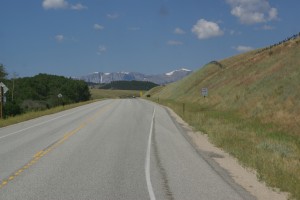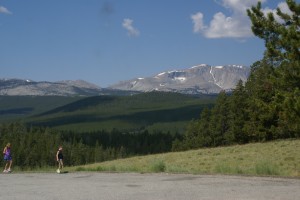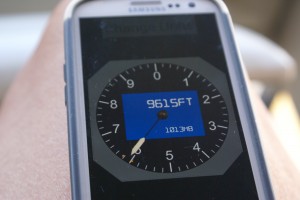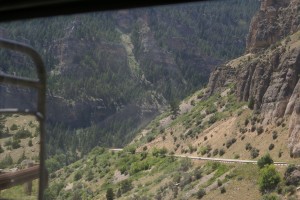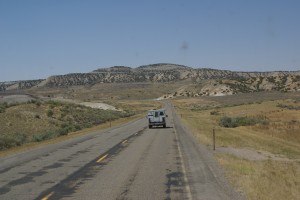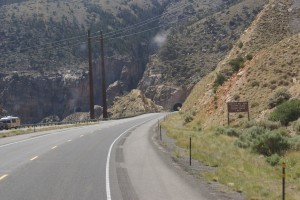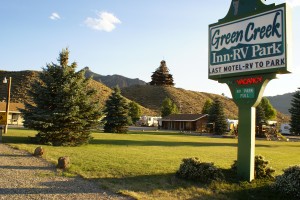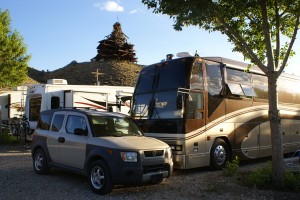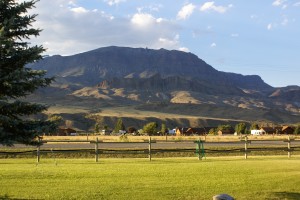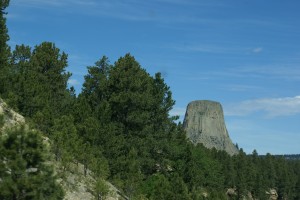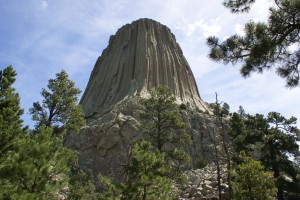We slept in this morning. We needed the extra rest before heading out. Linda got the interior of the coach ready to travel while I prepped the exterior/systems. I dumped the black and gray waste tanks and added fresh water to bring us up to 2/3 from 1/2 tank. We try not to haul around the weight of waste water, but like to have enough fresh water on board that we could boondock unexpectedly for at least a few days if we the need arose.
Most of our Habitat For Humanity team planned to leave this morning, but none of them pulled out at sunrise (as many RVers are want to do). Folks were out and about and wanted to have one last conversation, and one more chance to say “see you down the road”, before leaving. There was talk of a reunion build next year, and I suggested that we all e-mail Steven and ask him to arrange that. Peter D stopped by and thanked us for staying with him while working with HFH. No matter how long the farewells, eventually there is nothing left to say or do except turn the key and drive away. We pulled out of our spot at Peter D’s just before 10 AM MDT.
I had scoped out the Exxon station at I-90 exit 25 yesterday in case we needed to add diesel fuel. They had just what we needed: convenient to the highway exit, a truck lane with easy access, dual large-nozzle pumps, and no overhead obstructions. We had somewhere between 5/8 and 3/4 of a tank of diesel fuel. I don’t like to get below 1/4 tank, so conservatively we had 3/8ths to 1/2 of a tank of useable fuel. We have a 235 gallon tank, but I treat it as a 200 gallon one, so I figure 25 gallons per 1/8th tank.
Past calculations have indicated that we get about 6 mpg, so I figure on 5 mpg, again being conservative, and especially today as we have never driven the bus through high mountains before. That works out to approximately 125 to 150 miles per 1/8th tank of fuel, or 375 to 450 miles based on what we currently had on board. Our trip from Sheridan to Wapiti was calculated at 240 miles, so we had enough fuel on board to make that distance and still have sufficient reserves for an emergency detour or layover. As we would be crossing the Bighorn Mountains, we did not want to carry unnecessary weight, so we decided we did not need to top off.
Perhaps it’s a holdover habit or frame of mind from when I used to fly airplanes 35 to 40 years ago, but I think such calculations are necessary when traveling in a vehicle that cannot just pull into the next filling station or convenience mart, assuming there even is one along the route, and fill up the fuel tank. Generally speaking, the bus likes to stop here the big trucks do. Not only is access good, but truck stops turn over their diesel fuel frequently, so it is generally fresh.
We got on I-90 at exit 23 and headed south to Buffalo where we picked up US-16 headed west over the Bighorn Mountains. As previously posted, we had been advised not to take US-14 from Sheridan to Lovell as the grades are a little steeper and there are more switchbacks and hairpin turns, and fewer turnouts, than on US-16. Having driven US-14 and US-14A in our car, we accepted the recommendation.
US-16 was a dramatically beautiful drive, but it was no walk in the park. The road was good pavement with wide lanes, good signage, and lots of pullouts, albeit not always exactly where I needed or wanted them. I had not driven the coach in mountains prior to this leg and US-16 started climbing as soon as we left Buffalo headed west. It took me a while to figure out what gear to put the Allison 755CR (ATEC) transmission in, what RPM to try to hold, and what exhaust manifold temperatures, engine coolant temperatures, and vehicle speed to expect from that combination. The engine got up to 210 degrees on this initial climb but I was able to find a pullout soon after and let it cool off. That is the upper temperature limit for the heads, and I did not let it get that hot again. The engine continued to run well all the way to our destination, so “no harm, no foul” (I hope).
With no prior mountain experience in this coach we really did not know what to expect from the Detroit Diesel 8V92TA engine. Now we do, and I admit I was disappointed, which is to say, I was hoping for more performance. It is, after all, a turbo-charged 450 HP 2-cycle diesel. That sounds like a lot of engine, and it runs well on flatter ground, but in all fairness it was pushing a 40,000+ pound bus that was pulling a 4,000 pound car from 3,600 ft. ASL to 9,600 ft. ASL in a relatively short distance on a somewhat warm day. On the plus side, it got us to Granite Pass at 9,630 ft. ASL, although I was in first gear turning 2,000 RPM and going about 20 MPH at that point. Still, it got us there.
What goes up must come down. I have attended enough seminars at RV rallies to know that “whatever gear you use to climb the hill is the gear you use to descend the hill.” I also knew the rule about braking on downgrades; “apply them hard to get your speed down quickly and then get off them to let them cool; do not ride your brakes or they will overheat and fail.” I followed both rules coming down the western side of the Bighorns. This stretch of US-16 has an 18 mile long section of frequent (perhaps continuous?) 6% grade.
Our engine has a two-stage transmission retarder instead of a Jacobs (Jake) Brake. I have never driven a vehicle equipped with a Jake Brake, so I don’t know well they perform, but I rate the transmission retarder on our Allison transmission marginally effective. At best it was not able to hold our downhill speed in check without the frequent application of the brakes. At one point we started to get a slight bunt smell and I pulled into the next turnout to let the brakes cool. I checked the passenger side front brake rotor with an infrared remote sensing temperature gun and got 750 degrees. The passenger side tag axle brake rotor was about 600 degrees. I couldn’t check the drive axle brakes because of the physical configuration of the dual wheels. At another turnout I was slightly nose down and the emergency/parking brakes would not quite hold the coach, so I had to sit with my foot on the brakes while they cooled.
As on the climb up, I was often in 3rd or 2nd gear going down, and on the steepest descents I was in 1st gear going 16 to 20 MPH. What I finally figured out was that I could let the RPMs get up to about 2,200, apply the brakes until the RPMs dropped to about 1,700, then let off the bakes and let the MPH and RPM creep back up, and then do it all over again, and again, and again. The DD 8V92TA redlines at about 2,350 RPM, so that is a figure not to be exceeded, and is generally best avoided.
I have to admit that this was a stressful drive, not made any easier by the fact that it was past noon with bright sunshine heating up the front of the coach and no ability to use the OTR bus AC as we already lacked power for the climb. Add to the mix that the chassis battery BAL (balance) light would flash on occasionally, indicating a possible problem the Vanner equalizer, and well…it was work. But it was still beautiful.
We made it over the Bighorn’s and rolled through Tensleep headed for Worland. We rolled through Worland too, but noticed what appeared to be a very nice museum. It had a large statue of a Mastodon out front, so we presume the museum was dedicated to the natural wonders of the Bighorn Valley. Apparently the Bighorn Valley has produced some world class dinosaur fossils. Alas, we were anxious to make time and get to our destination, so we Nick Russell’d the museum and said we would have to return some day to see it.
US-16 joins up with US-20 at Worland whence they head north to Greybull. This part of the drive was similar to the drive we did from Lovell to Greybull over a week ago. The landscape is desolate but stunning and the road goes up and down long, rolling hills. US-16/20 joins US-14 at Greybull and turns west towards Cody. This part of the drive was relatively flat and visually less interesting than what we had seen up to that point. It didn’t help that it was hot and I was tired, so I finally turned on the OTR bus AC.
We could see the Absaroka Range ahead of us, but it became more distinct as we neared Cody. US-14/16/20 goes right through the heart of Cody, so we got a good look at the town as we drove through at 25 MPH, one of many RVs passing through. Cody appeared to be a historic town with a modern vibe. We decided we would take one of our days and drive to town and check it out.
US-14/16/20 continues west out of Cody and follows the Shoshone (Shoshoni) River through the Shoshone Canyon/Valley 50 miles to the East Entrance of Yellowstone N. P., where all three highways reach their western terminus. Our destination, however, was the Green Creek Inn and RV Park in Wapiti, about 18 miles up the road from Cody. Cody sits at 5,000 ft. ASL and Wapiti is at 5,700 ft. ASL, so we were climbing gently the whole way.
Not far out of Cody we drove through three tunnels in quick succession and reached the Buffalo Bill Dam and Reservoir. We made a note to stop at the Visitor Center on a trip back to Cody (in the car). The reservoir is large, with lovely water, surrounded by rock cliffs and dry, brown hillsides. The contrast was striking. There is a Wyoming state park along most of the north shore of the reservoir with two campgrounds, both of which were mostly empty.
Wapiti is more a dot on a map than an actual, distinct town, but it has a post office and one of the oldest continuously operating schools (currently K-5) in the nation. The Green Creek Inn and RV Park is on the far western edge of what is considered Wapiti, just past what claims to be the last filling station before reaching Yellowstone N. P. It also sits in the shadow of the Smith Mansion, a very recognizable landmark on this route.
We and another RV had to wait a short while to get into our sites while someone else finished unhooking and pulling out, but Jeff (the owner) got us both parked. We then went about our usual arrival/encampment routine. The Green Creek Inn and RV Park is a basic but nice place in a dramatic setting, and we have a 50A full-hookup site (one of two). Our rig won’t fit in the campgrounds at Yellowstone N. P., so we will be driving there in our car. Green Creek was the closest RV park to the East Entrance we could find.
The Smith Mansion was built by Lee Smith starting in 1973, and he worked on it until he fell to his death in 1992. It is a log structure, more imagined than designed, and presents a striking image up on its hilltop setting. Some of the timbers were harvested from nearby forests devastated by wild fires and it appears from a distance that other materials were probably salvaged. It has fallen into serious disrepair over the last 21 years, made worse by vandals. It is posted “private property” and is not open to the public at this time. There is a trailer parked on the property with a caretaker/guard. There is a foundation trying to raise funds to preserve, restore, and complete the house, as explained on their website. The foundation was started by Smith’s daughter and her husband, but there is no indication of who actually owns the house/property, or who else is involved in the foundation.
